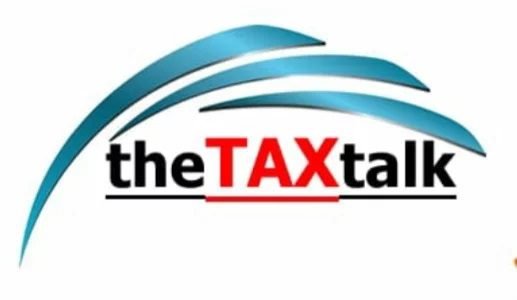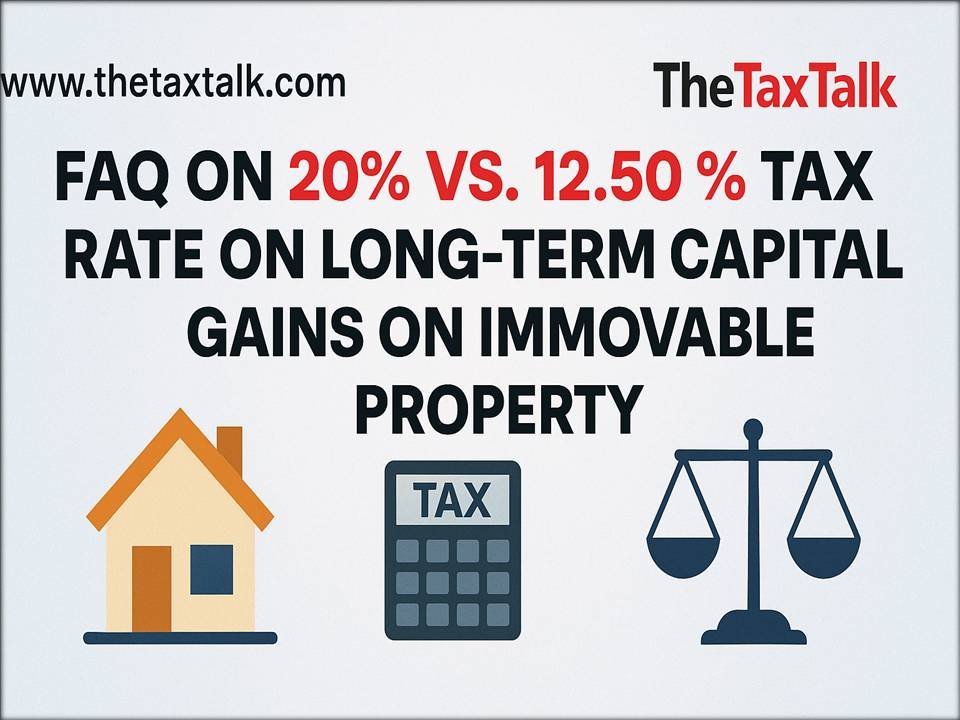![]()
FAQ on 20% Vs. 12.50 % Tax Rate on Long-Term Capital Gains on Immovable Property
1. What exactly changed in the LTCG rules from 23 July 2024?
• Before 23 July 2024: Sale of immovable property (held for ≥2 years) was taxed at 20% with indexation.
• After 23 July 2024:
• Default: 12.5% tax without indexation.
• Option (for assets bought before 23 July 2024): Continue with 20% with indexation if it results in lower tax.
2. What is meant by “grandfathering”?
• If you purchased the immovable property before 23 July 2024, you can choose:
1. 20% with indexation, or
2. 5% without indexation.
• You can compute both ways and pick the one giving lower tax.
3. If I buy property after 23 July 2024, can I claim indexation?
• No. For property purchased on or after 23 July 2024, LTCG will always be taxed at 12.5% without indexation. No choice available.
4. Who can use this 20% vs 12.5% option?
•Only:
• Resident Individuals, and
• Hindu Undivided Families (HUFs)
• Not available to:
• Companies, Firms, LLPs, AOPs, BOIs
• Non-residents
5. Is this benefit for all capital assets?
• No. Only for land and building (residential, commercial, plot, etc.).
• Other assets (gold, shares, jewellery, etc.) → Always 12.5% without indexation.
6. Can I set off capital loss if I use the 20% with indexation method?
• Loss after indexation → Cannot be set off or carried forward. It lapses.
• Loss without indexation → Can be set off or carried forward as before.
7. How do I decide which option to pick?
1. Compute indexed gainand tax @ 20%.
2. Compute non-indexed gainand tax @ 12.5%.
3. Choose the lower tax amount.
8. Did the computation method change under Section 48?
• The mechanism in Section 48 is mostly unchanged except that indexation is now restricted to:
• Transfers before 23 July 2024, or
• Eligible grandfathered cases after that date.
• For most post-23 July sales, cost will be taken without indexation; only the tax rate choice is given in Section 112.
9. What about Section 54 and 54EC exemptions?
• Key change: Since gains are now computed without indexation for the purpose of exemptions, the LTCG figure will be higher.
• This means:
• You’ll have to reinvest a larger amount to claim full exemption.
• For 54EC bonds, the ₹50 lakh limit will make full exemption harder.
10. Does the 2-year holding period for LTCG still apply?
• Yes. Holding <2 years → Short-Term Capital Gains, taxed at your slab rate.
11. If I bought property before 1 April 2001, can I still use FMV as on 1 April 2001?
• Yes, you can still take the lower of:
• Stamp duty value on 1 April 2001, or
• Fair market value on that date.
12. What’s the “surcharge trap” I keep hearing about?
• The tax rate choice doesn’t remove surcharge.
• If your total income (including the capital gain) exceeds ₹50 lakh, surcharge applies as per slab:
• Up to ₹1 crore → 10% surcharge
• ₹1–2 crore → 15%
• ₹2–5 crore → 25%
• Above ₹5 crore → 37% (but capped at 15% for certain sections like 111A/112/112A – not for these property gains)
13. Numerical Example – Grandfathered Property
Facts:
• Purchase price: ₹1 crore (FY 2010–11)
• Sale price: ₹3 crore (Aug 2024)
• CII purchase year: 167, CII 2024–25: 363
Option A – 20% with indexation:
Indexed cost = ₹1 crore × (363 ÷ 167) = ₹2.173 crore
Gain = ₹3 crore – ₹2.173 crore = ₹0.827 crore
Tax = 20% × ₹0.827 crore = ₹16.54 lakh
Option B – 12.5% without indexation:
Gain = ₹3 crore – ₹1 crore = ₹2 crore
Tax = 12.5% × ₹2 crore = ₹25 lakh
Choose Option A (lower tax).
14. Bottom line
• The new law is simpler in writing but trickier in planning.
• Buy before 23 July 2024? You have a choice – do the math both ways.
• Buy after 23 July 2024? It’s always 12.5% without indexation.
• Watch out for loss treatment rules and surcharge thresholds.


